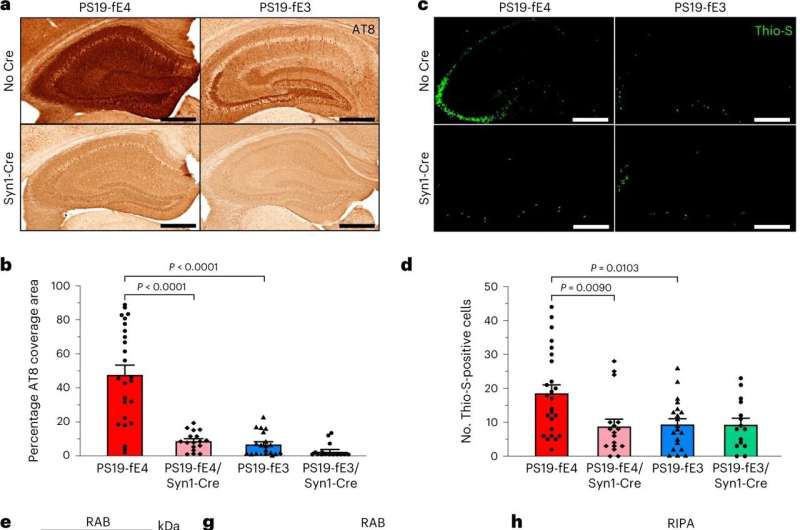This article has been reviewed according to Science X's editorial process and policies. Editors have highlighted the following attributes while ensuring the content's credibility:
fact-checked
peer-reviewed publication
trusted source
proofread
Impact of key Alzheimer's protein depends on type of brain cell in which it is produced

Of all the known genetic risk factors for late-onset Alzheimer's disease, the strongest is a gene for the protein called ApoE4. People with one copy of this gene are 3.5 times more likely, on average, to develop Alzheimer's than others, and those with two copies face a 12-fold increased risk. However, exactly how ApoE4 boosts the risk of Alzheimer's remains unclear.
Multiple types of cells in the brain make ApoE4—some of it is produced by neurons, but other brain cells called glia make it in higher quantities. For that reason, most prior research on this protein has focused on ApoE4 from glia.
Now, researchers at Gladstone Institutes are shining a brighter spotlight on ApoE4 produced by neurons. In a study published in Nature Aging, they demonstrate in mice that ApoE4 from neurons plays a much bigger disease-driving role in Alzheimer's than previously thought.
"This research could be a turning point in the field of ApoE research," says Gladstone Senior Investigator Yadong Huang, MD, Ph.D., senior author of the study. "Our findings suggest an opportunity to explore new treatments that would specifically target neuronal ApoE4 to protect against Alzheimer's disease."
Deleting ApoE4 in neurons to reveal its role
ApoE4 is actually one of three versions of the ApoE protein, which is found in every person's body. Most people have the "healthy" version, ApoE3, while about 12 percent have the Alzheimer's-protective version, ApoE2. But about 25 percent of North Americans have one copy of the gene for ApoE4, and up to 3 percent have two copies.
Most ApoE in our brains is produced by a type of glial cell called astrocytes, and previous research suggested that astrocytic ApoE4 contributes to Alzheimer's disease. However, evidence from Huang and colleagues has hinted for several years that ApoE4 from neurons may play an even more important part.
"Under normal conditions, neurons don't make much ApoE at all, but when under stress or in response to injury, they quickly increase production of this protein," says Huang, who is also director of the Center for Translational Advancement at Gladstone, and professor of neurology and pathology at UC San Francisco (UCSF). "That's why we are very interested in neuronal ApoE4 under disease conditions."
To better understand the protein's role, his team created a mouse model for Alzheimer's disease in which the mouse ApoE gene was replaced by the human gene for ApoE4 or ApoE3. The mice also carry a unique form of the human tau protein that accumulates in the brain with aging—a hallmark of Alzheimer's disease. Importantly, in the genetically engineered mice, ApoE production by neurons could be selectively eliminated, while preserving the production of ApoE by other cell types, allowing the scientists to examine exactly how deleting neuronal ApoE4 impacts disease progression in mice that mimic Alzheimer's disease.
Striking results of protection
The scientists found that removing ApoE4 from neurons reduced many brain changes resembling Alzheimer's disease.
In the models, deleting neuronal ApoE4 reduced the abnormal accumulation of tau by over 80 percent. It also protected against loss of neurons and shrinkage of the hippocampus, a part of the brain crucial for memory formation that degenerates in Alzheimer's patients.
In addition, deleting neuronal ApoE4 protected against loss of myelin sheaths—insulating layers that shield neurons and help their electrical signals travel faster. It reduced overexcitation of neurons, which often occurs in Alzheimer's disease, and it decreased the abnormally intense reactions of glial cells—key contributors to degeneration—commonly seen in the disease.
"These extensive reductions in pathology were striking, especially since neuronal ApoE4 only accounts for a small portion of the ApoE produced in the brain," says Nicole Koutsodendris, Ph.D., lead author of the study, and former graduate student in Huang's lab at Gladstone and in the Developmental and Stem Cell Biology program at UCSF.
"Our results strongly suggest that neuronal ApoE4 is critical for the development of Alzheimer's disease in ApoE4 carriers," Huang says.
A new direction for drug development
While some medications and other treatments may slow the progression of Alzheimer's disease or help treat symptoms, no cure exists yet. And patients are in urgent need of solutions.
By establishing a key role of neuronal ApoE4, Huang's team opens up new possibilities for the treatment of Alzheimer's disease. For instance, drugs or gene-editing strategies could be developed to block mechanisms responsible for the production of ApoE4 within neurons.
"Our findings highlight the therapeutic potential of reducing neuronal ApoE4 in Alzheimer's disease," says Huang. "They open up exciting new opportunities for the development of better drugs or strategies to treat this devastating disease."
More information: Nicole Koutsodendris et al, Neuronal APOE4 removal protects against tau-mediated gliosis, neurodegeneration and myelin deficits, Nature Aging (2023). DOI: 10.1038/s43587-023-00368-3

















